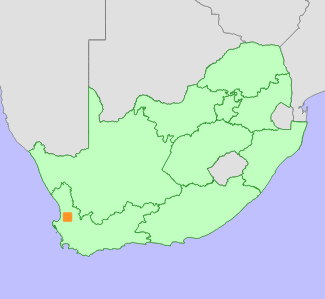|
Scientific Name | Polycarena subtilis Hilliard |
Higher Classification | Dicotyledons |
Family | SCROPHULARIACEAE |
Synonyms | Polycarena silenoides of other authors, not of Harv. ex Benth.: Hiern (1904) (in part) |
National Status |
Status and Criteria | Endangered B1ab(ii,iii,iv,v)+2ab(ii,iii,iv,v) |
Assessment Date | 2007/05/22 |
Assessor(s) | D. Raimondo |
Justification | EOO <460 km² the majority of its habitat (c. 80%) has already been converted for rooibos tea, potato and citrus cultivation. Fewer than five locations are likely to be extant. Conversion of habitat for potato and rooibos tea cultivation is ongoing. |
Distribution |
Endemism | South African endemic |
Provincial distribution | Western Cape |
Range | Olifants River Valley south of Clanwilliam to Piketberg. |
Habitat and Ecology |
Major system | Terrestrial |
Major habitats | Olifants Sandstone Fynbos, Leipoldtville Sand Fynbos |
Description | Sandy flats. |
Threats |
| Threatened by severe ongoing habitat loss and fragmentation due to rapidly expanding rooibos tea and potato cultivation on sandy flats, which have already resulted in nearly 80% loss. |
Population |
Population trend | Decreasing |
Assessment History |
Taxon assessed |
Status and Criteria |
Citation/Red List version | | Polycarena subtilis Hilliard | EN B1ab(ii,iii,iv,v) | Raimondo et al. (2009) | |
Bibliography |
Goldblatt, P. and Manning, J.C. 2000. Cape Plants: A conspectus of the Cape Flora of South Africa. Strelitzia 9. National Botanical Institute, Cape Town.
Hilliard, O.M. 1994. The Manuleae: a tribe of Scrophulariaceae. Edinburgh University Press, Edinburgh.
Raimondo, D., von Staden, L., Foden, W., Victor, J.E., Helme, N.A., Turner, R.C., Kamundi, D.A. and Manyama, P.A. 2009. Red List of South African Plants. Strelitzia 25. South African National Biodiversity Institute, Pretoria.
|
Citation |
| Raimondo, D. 2007. Polycarena subtilis Hilliard. National Assessment: Red List of South African Plants version 2024.1. Accessed on 2025/12/03 |
 Comment on this assessment
Comment on this assessment


